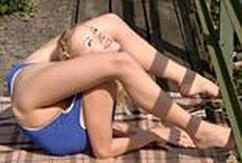Exercise for good posture, not good posing.
 Yogis need to take care, as many people are unknowingly damaging their body by doing yoga twists without honoring the spine’s natural structure, which is made of curves—not straight lines. The spinal column is a dynamic, flexible rod acting as a support structure for our body and nerves. The basic design is four opposing curves: neck, upper back, lower back and tailbone, allowing our trunk to flex, extend and twist. In positions without these curves, twisting movement becomes difficult, and flexibility comes at the cost of overstretched spinal ligaments, compressed or herniated discs and even compression fractured vertebrae. While most people are aware that one should avoid yoga twists when there is disc herniation or nerve impingement, many yoga twists require complex body positions that can reverse the curves of the spine, causing damage to an otherwise healthy body. The human spine consists of 24 vertebrae that vary in size, shape, and function, separated and cushioned by discs which help to create shock absorption to protect our joints as we move, as well as providing a framework to support our nerves. When we are born, we have a C shape to the spine that consists of one primary curve forwards, which makes it necessary to support a baby’s neck until he gets the muscle actions that create the spinal curves. As he begins to lift his head from the belly down position, extensor muscles in the back body from sacrum to skull, engage and create the secondary backwards curves of the lumbar (lower back) and cervical (neck area). For FULL article click HERE.
1 Comment
|
ArchivesCategories |
 RSS Feed
RSS Feed